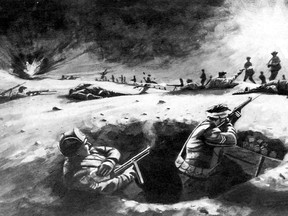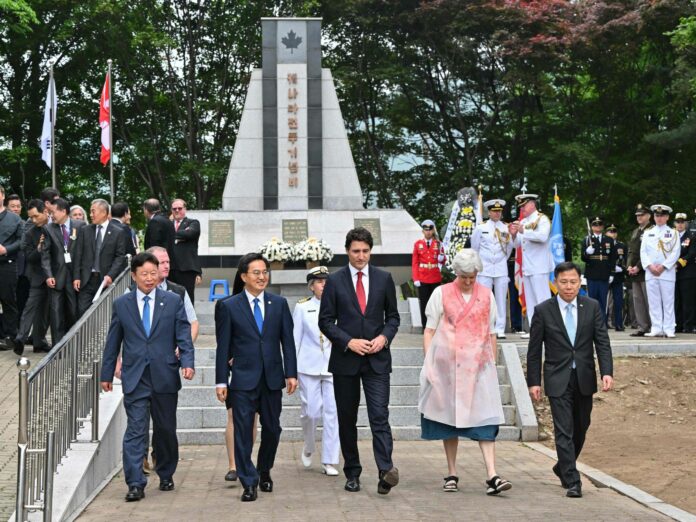Many Canadian Korean War veterans believed they never got the recognition given to those who had fought in the world wars.
Article content
On his recent visit to South Korea, before travelling on to Japan for the G7 meeting, Prime Minister Justin Trudeau opened the new Kapyong Memorial Trail. Not only did he participate in the ceremonial opening but afterward he and students from the Calvin Manitoba International School in Incheon made a two-hour hike along the trail to the top of the hill.
Advertisement 2
Article content
In doing so, he paid homage to those members of the Princess Patricia’s Canadian Light Infantry who fought there, but also he reminded Canadians of what is often called “the forgotten war.”
The Korean War was fought between 1950 and 1953. Korea itself had been occupied by Japan since 1910 until Japan surrendered at the end of the Second World War. The North was soon liberated by the Soviet Union, which set up a puppet government. The South was liberated by the United States and was slowly becoming a democracy. The territories were roughly divided at the 38th Parallel.
On June 25, 1950, the north suddenly invaded the South, intent on unifying the country under its leadership. The capital city of Seoul was soon captured. The United Nations called on the North to withdraw. When it did not, the UN called on its members to form a multinational force to stop the aggression. Not wanting to refer to the move as a war so soon after the end of the Second World War, it called it simply a “police action.”
Article content
Advertisement 3
Article content
Canada responded, sending ships and later an armed force of three battalions of infantry plus support units. An airbase was established in Japan to shuttle supplies from North America to Japan and on to South Korea.
Before the Canadian soldiers reached Korea, the U.S. launched an amphibious attack at Incheon, driving the North Koreans back over the 38th parallel and liberating Seoul. As the ship carrying the first contingent of Canadian soldiers was reaching Korea, the war seemed to be settling into static warfare with each side holdings its lines.
But Kapyong (also spelled Gapyeong) was an exception. On April 22 to 25, 1951, Canada and Australian forces were guarding the Kapyong River Valley, which was a direct route to Seoul. The Australians were on the east side while a single company of the Princess Patricia’s Canadian Light Infantry was on top of Hill 677 on the west side, less than three kilometres away. The Chinese launched a massive assault on the Australians and forced them to withdraw. On the night of April 24, the Chinese attacked the Canadians. The Canadians held on, fighting with rifles and hand grenades. When the advance kept coming, it became hand-to-hand combat.
Advertisement 4
Article content

Finally, as the Canadians were on the verge of being overrun, the commanding officer, Capt. Wally Mills, ordered his men to take cover in their slit trenches and then called down artillery fire on their own position. This caught the Chinese by surprise and they withdrew. Ten Canadian soldiers were killed and 23 wounded in the fighting. The Australians lost 32 killed, 59 wounded and three missing. Between 1,000 and 5,000 Chinese are believed to have had been killed.
In the morning, U.S. supply aircraft air-dropped food, water and ammunition to the Patricias. The PPCLI continued to hold their position until they were relieved.
Later, the PPCLI were awarded the United States Presidential Unit Citation, a rare honour for a Canadian unit.
Advertisement 5
Article content
Over the course of the war, approximately 26,000 Canadian served. Of these, 516 were killed.
Still, many Canadian Korean War veterans believed they never got the recognition given to those who had fought in the world wars. It was not until 1991 that the Canadian veterans were awarded the Canadian Volunteer Service Award with its own bar which says “Korea.” In 1997, the Korean War Memorial was established in Brampton, Ont. On Oct. 17, 1998, U.S. President Bill Clinton signed Public Law 105-261; Section 1067, which formally declared “the Korean Conflict” to be the “Korean War.”
Canada and South Korea established the Canadian Korean War Memorial Garden at Kapyong to honour the fighting that occurred there. The new trail leads from the Garden up Hill 677, where the worst of the fighting occurred. Trudeau’s rugged hike is an excellent reminder of a hard-fought war that has faded in Canada’s collective memory.
Tom MacGregor writes on veterans and military heritage. Follow him: @MacGregorTom.
-

How John McCrae captured the spirit of those who died in war
-

Burtch and Cook: Kap’yong — What Canada learned from the first hot battle of the Cold War



Comments
Postmedia is committed to maintaining a lively but civil forum for discussion and encourage all readers to share their views on our articles. Comments may take up to an hour for moderation before appearing on the site. We ask you to keep your comments relevant and respectful. We have enabled email notifications—you will now receive an email if you receive a reply to your comment, there is an update to a comment thread you follow or if a user you follow comments. Visit our Community Guidelines for more information and details on how to adjust your email settings.
Join the Conversation